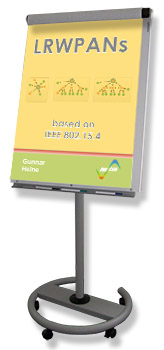LRWPANs based on IEEE 802.15.4
[2-day course, Euro 2,350.- (net) per participant]

Chapter 1: The Playground of ZigBee and Thread
- The IoT-Market
- Bluetooth and WiFi
- ZigBee vs Thread
- 3GPP-endorsed Technologies (NB-IoT and others), LoRa and SIGFOX
- Fundament of ZigBee and Thread: IEEE 802.15.4
- The IEEE 802.15-Family to standardize WPANs
- Typical Application Areas of ZigBee
- More formalized: Application Profile Examples of ZigBee
- Practical Excurse: View Parts of the ZHA
- Timeline of ZigBee
- ZigBee 2004
- ZigBee 2006
- ZigBee 2007 (ZigBee PRO)
- ZIgBee RF4CE
- ZIgBee IP
- ZigBee 3.0
Chapter 2: Warming Up: Basics and Technical Intro
- Network Topologies of WPANs
- Supported Network Topologies in ZigBee
- Star
- Tree
- Mesh
- Star
- Supported Network Topologies in ZigBee
- ZigBee / IEEE 802.15.4 Device Types
- ZigBee Gateway (ZG)
- ZigBee Trust Center (ZTC)
- ZigBee Coordinator (ZC)
- ZigBee Router (ZR)
- ZigBee End Device (ZED)
- Protocol Stacks
- Simplified ZigBee Pro Protocol Stack with related PDU-Types
- Fully-fledged ZigBee PRO Protocol Stack
- ZigBee Endpoints
- The ZDO / ZDP
- ZigBee Cluster Library
- ZigBee RF4CE Protocol Stack
- ZigBee IP Protocol Stack
- ZigBee 3.0 Protocol Stack
- Thread Protocol Stack
- Addressing
- Addressing of PANs
- Addressing of Devices
- Broadcast Addresses
- The XBee Development Kit
- Introduction and Hardware Look and Feel
- Default Configuration
- XCTU Screenshot
- Read/Write of XBee Configuration of PAN-coordinator and ZED
- Practical Example: New ZED joining the Network
- Frame No 1: ZED is powered up and sends Beacon Request
- Frame No 2: Beacon from Router
- Frame No 3: Beacon from PAN-Coordinator
- Frame No 7: Association Request
- Frame No 11: Association Response
- Frame No 15: Extended Address Request
- Frame No 17 and 19: Device Announcement
- Frame No 22: Extended Address Response
Chapter 3: Lower Layers: PHY and MAC Details of IEEE 802.15.4
- Frequencies and Channels
- General Remarks on the Operation IEEE 802.15.4
- CSMA/CA based operation
- ALOHA-based operation
- Beacon-less Operation
- Declaration of Beacon-less operation in IEEE 802.15.4 Beacon frames
- Uplink Data Transfer and
- ... Collision Risk with Aloha
- Polling for Downlink Data
- Wireshark-based Example for Polling for DL-Data
- CSMA/CA-Procedure unslotted
- Operation with Beacon and slotted CSMA/CA
- Superframes and their Structure in IEEE 802.15.4
- CSMA/CA-Procedure slotted
- BPSK-Modulation and Processing in IEEE 802.15.4
- O-QPSK -Modulation and Processing in IEEE 802.15.4
- Baseband Processing
- Pulse Shaping
- PPDU-Format
- Frame Transmission and Acknowledgement in IEEE 802.15.4
- Long Frame / Short Frame
- Acknowledged Mode / Unacknowledged Mode
- MAC-PDU Frame Structure
- Frame Control Field
- SN-Field
- Address Fields
- Aux Security Header
- MAC-Command Frames
- Association Request
- Association Response
- Disassociation Notification
- Data Request
- PAN Id Conflict
- Orphan Notification
- Beacon Request
- Coordinator Realignment
- GTS Request
Chapter 4: Upper Layers in ZigBee: NWK, APS, ZDO and ZCL100
- Tasks & Functions of the NWK-Layer
- Routing in ZigBee
- Options
- Distinction of Next-Hop vs End-to-End
- Details of Tree Routing
- Details of AODV-based Routing
- Example of AODV-based Routing in ZigBee
- Link Asymmetry
- Many-to-One Routing
- Source Routing
- Example: RREQ-Frame with "many-to-one" routing
- Example of AODV-based Routing in ZigBee
- NWK-Frame Format
- Frame Control Field
- Radius Field and SN field
- Address Fields
- Aux Security Header
- Security Level
- MIC (Message Integrity Code)
- Tasks & Functions of the APS-Layer
- APS-Frame Format
- Frame Control Field
- Dest and Src Endpoints
- Group Address
- Cluster Id and Profile Id
- APS Counter
- Aux Security Header
- Security Level
- MIC (Message Integrity Code)
- The Application Layer: Profiles, Cluster and Attributes
- Communication on the Application Layer
- Frame Format on the Application Layer
- Example for Manufacturer-specific APS-Data Frame
Chapter 5: Other Issues: Coexistence, Sniffing and Security
- Coexistence
- The Main Suspects and their Characteristics
- Coexistence with Bluetooth and Bluetooth Low Energy
- Physical Separation
- Power Control
- Slow Frequency Hopping
- Coexistence with WiFi
- Use WiFi Clear Channels for IEEE 802.15.4 based Networks
- PTA (Packet Traffic Arbitration)
- Security
- Scope of Encryption and Integrity Protection in Frames
- Key Distribution
- Sniffing
- Sniffer Configuration
- Walkthrough: The OpenSniffer and its Capabilities
- Main Hardware and Delivered Hardware
- User Interface and Configuration
- Network Scan and Results
- Energy Scan in 2.4 GHz and Results
v1.000
ℹ️ Try out the updated search below!
Search:
More Info:
Schedule of this training course
Our Training-Catalog
GSM Training Courses
(E)GPRS Training Courses
3G Training Courses
Multimedia & TCP/IP Training Courses
SS7 Protocol Stack Training Courses
Transmission & Access Technologies Related Courses
Bootcamps
